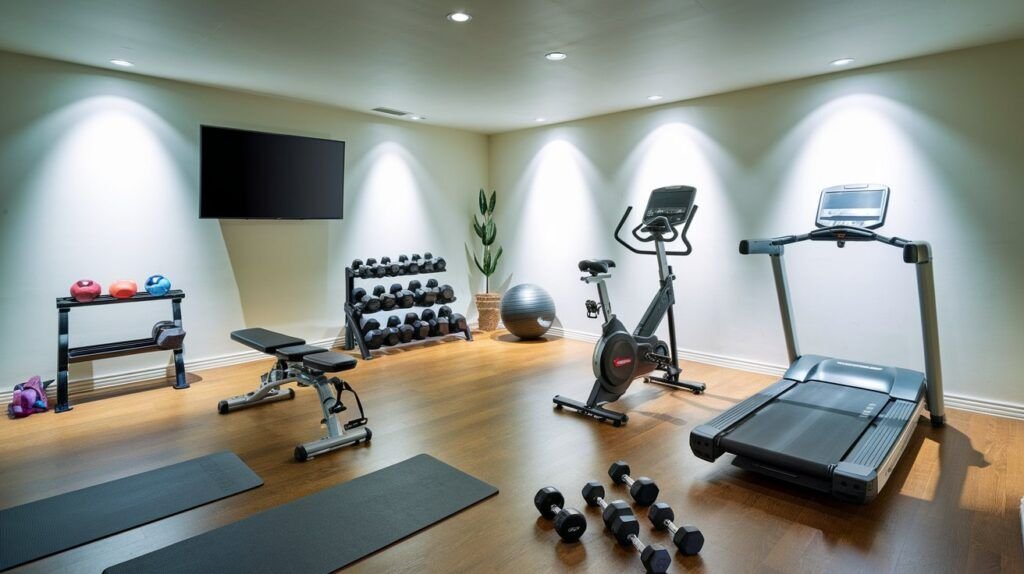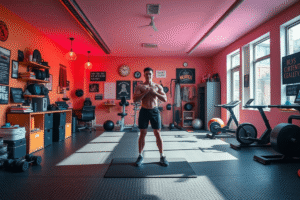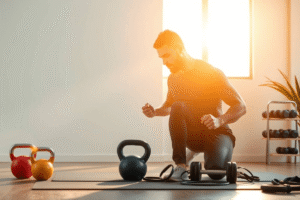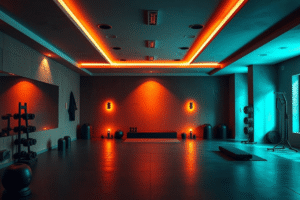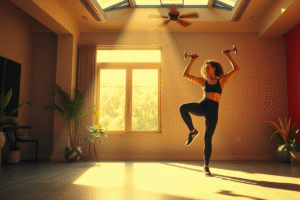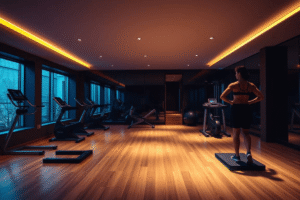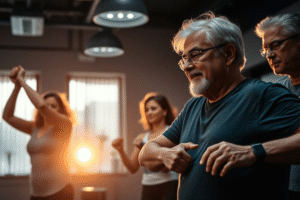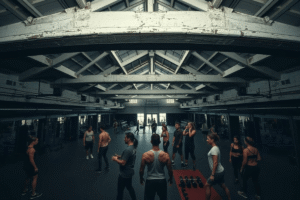Creating a home gym is a practical way to stay fit without needing to visit a fitness center. Setting up your own gym can save time, provide privacy, and allow you to exercise whenever you want. Yet, choosing the right equipment is crucial for making your home gym effective. Here, we are going to discuss the essentials you need for a home gym, ensuring your fitness goals.
1. Space and Layout Planning
Planning the space and layout of a home gym is a must for creating a functional and enjoyable workout environment. By considering the available space and your fitness needs, you can design an ideal gym.
Assess Available Space: Start by identifying a suitable location in your home. Common options include a spare room, garage, basement, or even a corner of your living area. Measure the dimensions to understand how much space you have for equipment. Ensure proper ventilation, lighting, and flooring to make a safe workout experience.
Define Your Fitness Goals: Your fitness goals will influence the type of equipment you need. For strength training, divide space for weights, a bench, and a power rack. If cardio is a priority, plan for a treadmill, exercise bike, or rowing machine. For yoga or Pilates enthusiasts, ensure enough open floor space for stretching and mat-based exercises.
Optimize Layout: Arrange equipment to maximize safety and usability. Keep larger machines along walls to free up central space for movement. Ensure there’s adequate clearance around each piece of equipment to prevent accidents. Organize smaller tools like resistance bands, dumbbells, and yoga blocks on racks or shelves. It will help you to avoid clutter.
Focus on Comfort and Aesthetics: Add mirrors for form-checking and a sound system for motivation. Use rubber or foam mats for noise reduction and floor protection. Bright, energizing colors can create a motivating environment.
Proper space and layout planning not only make your home gym functional but also turn it into a motivating space for achieving fitness goals.
2. Cardio Equipment
Cardio equipment helps improve heart health, burn calories, and enhance stamina. Choose equipment that fits your goals and space:
Treadmill: Perfect for walking or running indoors.
Stationary Bike: Great for low-impact cardio workouts.
Rowing Machine: Works on both cardio and strength by engaging many muscle groups.
Jump Rope: A budget-friendly and space-saving cardio option.
3. Strength Training Essentials
Strength training is essential for building and toning muscles. The following items are perfect for a home gym:
Dumbbells: Choose adjustable ones to save space and cover various weight ranges.
Kettlebells: These add versatility to your workouts with movements like swings and lifts.
Barbell and Weight Plates: Ideal for heavy lifting and compound exercises like squats and deadlifts.
Resistance Bands: Affordable and beneficial for both beginners and advanced users to add resistance.
Pull-Up Bar: Perfect for upper-body strength and core engagement.
4. Multi-Purpose Machines
A multi-purpose machine can combine several workout options in one piece of equipment, saving space and money. Look for:
Cable Machines: Allow a range of exercises for arms, legs, and chest.
Smith Machines: Provide a safe way to lift weights without a spotter.
Power Rack or Squat Rack: Essential for heavy lifts like squats and bench presses.
5. Bodyweight Training Equipment
Bodyweight exercises are effective and need minimal equipment. Include these in your home gym:
Push-Up Bars: Help improve push-up form and reduce wrist strain.
Ab Roller: Targets the core muscles effectively.
Dip Bars: Great for upper-body strength exercises.
6. Flooring and Safety Accessories
To protect your floors and ensure safety, invest in proper gym flooring and safety equipment:
Exercise Mats: Provide comfort and stability during workouts.
Rubber Mats or Flooring: Protects your floor from heavy weights and offers cushioning.
Mirrors: Help check your form and make the space feel bigger.
First Aid Kit: Always keep a basic kit nearby for emergencies.
7. Flexibility and Recovery Tools
Flexibility and recovery tools are essential components of a well-rounded home gym. They help improve mobility, prevent injuries, and aid in post-workout recovery. These tools are typically compact, affordable, and versatile, making them an excellent addition to any fitness setup.
Essential Flexibility Tools
Foam Rollers: Foam rollers are excellent for self-myofascial release, helping to relieve muscle tightness and improve blood circulation. They come in various densities to suit different comfort levels and muscle needs.
Stretching Straps: Stretching straps, or resistance bands, assist in deepening stretches and improving range of motion. They are particularly useful for hamstring, shoulder, and back stretches.
Yoga Blocks and Mats: Yoga blocks provide support during flexibility exercises, while a high-quality yoga mat offers cushioning and grip, enhancing comfort and safety during stretches or yoga sessions.
Recovery Tools
Massage Balls: These small tools target specific muscle knots and tension, especially in hard-to-reach areas like the shoulders and feet.
Percussion Massagers: Advanced recovery tools like massage guns offer deep tissue massage to alleviate soreness and speed up muscle recovery.
Cold and Heat Therapy Packs: Ice packs and heating pads reduce inflammation and relax muscles post-exercise.
Benefits of Flexibility and Recovery Tools: These tools not only enhance flexibility but also prevent stiffness, reduce the risk of injury, and improve overall athletic performance. By dedicating a small space in your home gym to these tools, you can ensure a balanced approach to fitness that prioritizes recovery and long-term health.
8. Cardio and Strength Accessories
Small accessories can greatly enhance your workouts:
Jump Rope: Great for warm-ups and cardio.
Weighted Vest: Adds resistance to bodyweight exercises.
Medicine Ball: Perfect for strength and cardio combined workouts.
9. Technology and Entertainment
Keep your workouts engaging and track your progress:
Fitness Tracker or Smartwatch: Monitors heart rate, steps, and calories.
Bluetooth Speakers: Add music to your sessions for motivation.
Tablet or Phone Stand: Useful for following workout videos or online classes.
10. Organization and Storage
A clutter-free gym enhances your workout experience. Use these storage solutions:
Wall-Mounted Racks: Save space by hanging resistance bands and ropes.
Weight Racks: Keeps dumbbells and plates organized.
Storage Bins or Cabinets: Store smaller accessories neatly.
11. Budget Considerations
When planning a home gym, budget considerations are essential for creating a functional and cost-effective space. Start by determining how much you’re willing to spend and prioritize versatile essentials. Such as resistance bands, dumbbells, and a yoga mat, which are affordable and able to do various workouts. Gradually expand your gym by adding equipment like kettlebells, barbells, or cardio machines as your budget allows.
Find second-hand options or discounted deals for quality equipment at lower prices. Investing in space-saving, multi-functional tools like adjustable dumbbells or all-in-one machines can also help you save money while maximizing utility. Comparing brands and researching reviews ensure you choose durable items within your price range. By planning carefully and building your gym gradually, you can achieve a fitness setup connected to your needs without overspending.
12. Customization Based on Goals
Your equipment choices should align with your fitness goals. For example:
Weight Loss: Focus on cardio machines and resistance bands.
Strength Building: Invest in barbells, weight plates, and a power rack.
Flexibility: Add yoga mats and foam rollers.
13. Benefits of a Home Gym
A home gym offers a convenient and cost-effective way to maintain a healthy lifestyle. One of its primary benefits is accessibility. With a home gym, you can exercise anytime, eliminating the need to commute to a fitness center. This flexibility allows you to fit workouts into your schedule, even on busy days.
Cost savings is another advantage. Although setting up a home gym needs an initial investment. It eliminates monthly gym membership fees and travel expenses. It saves money in the long run. Moreover, you have the freedom to customize your gym according to your fitness goals. You can choose equipment that suits your needs and preferences.
A home gym also provides privacy and comfort. You can work out without the distractions or crowds often found in public gyms. This personal space fosters focus and encourages consistency. Additionally, it ensures hygiene, as you control the cleanliness of your workout area.
Safety and family engagement are other notable perks. Exercising at home reduces the risk of accidents during travel. It allows family members to join in, promoting a collective commitment to health.
Lastly, having a home gym removes common barriers to fitness. Such as adverse weather or restrictive gym hours. It empowers you to stay consistent with your fitness journey. At the same time, it is a practical and rewarding choice for long-term health.
Thus, a home gym is a versatile, private, and cost-effective way to achieve fitness goals. Having a home gym offers many advantages:
Convenience: Workout anytime without traveling.
Privacy: Exercise in your comfort zone.
Savings: Avoid monthly gym fees.
Personalization: Tailor the gym to your needs and preferences.
To Conclude
A home gym is a valuable investment in your health and fitness journey. Start with basic equipment like dumbbells, a yoga mat, and resistance bands. Gradually add more based on your needs. By focusing on your fitness goals and space constraints, you can create a gym that motivates and supports you every day. Whether it’s for strength, cardio, or flexibility, your home gym can become the perfect place to achieve your fitness aspirations.
Stay Updated and Inspired
Subscribe to our newsletter for expert tips, gear recommendations, and home workout guides delivered straight to your inbox. Take the next step in building a better, smarter fitness routine — right from home!

